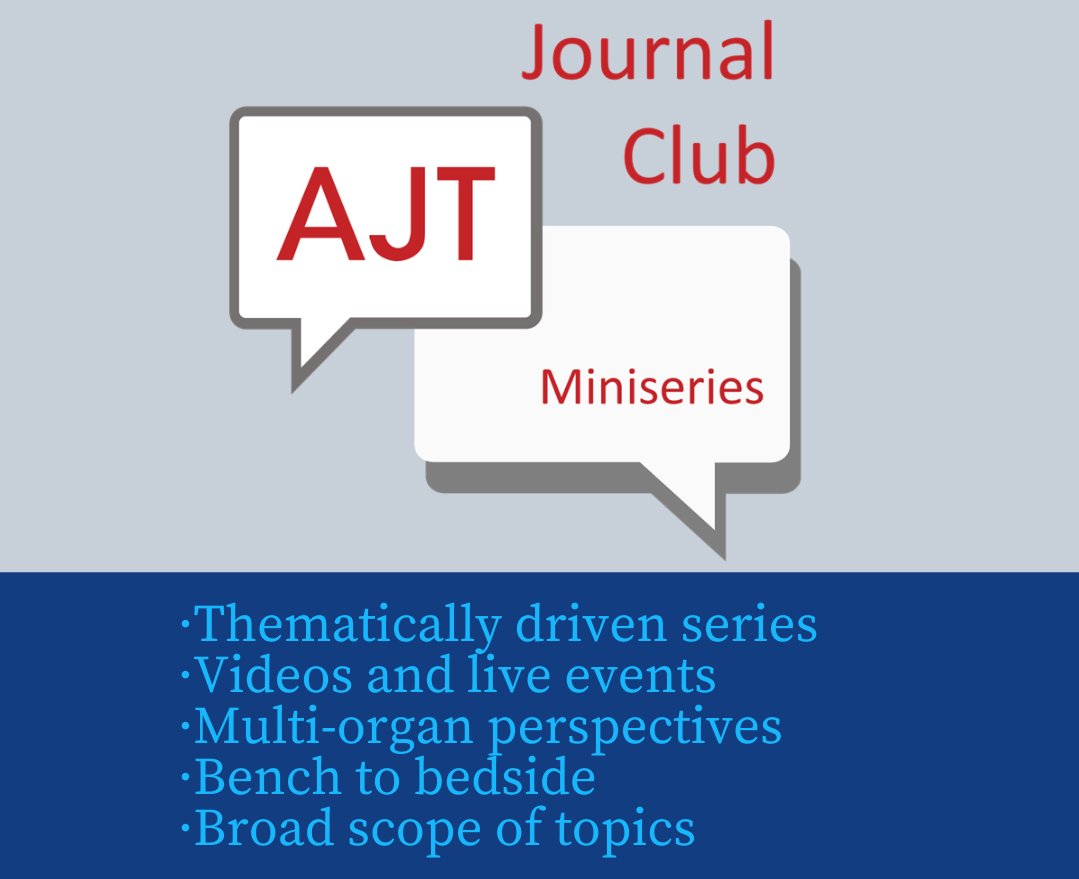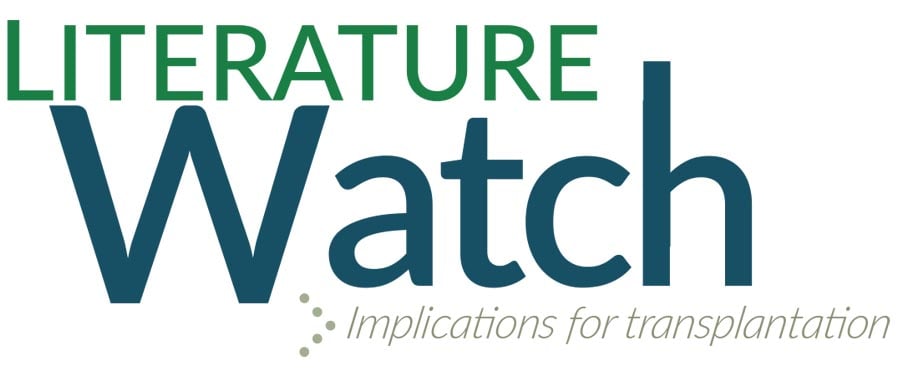Journal list menu
Export Citations
Download PDFs
Editorials
Histologic Findings from Positive Crossmatch or ABO-Incompatible Renal Allografts: Accomodation or Chronic Allograft Injury?
- Pages: 1753-1754
- First Published: 13 July 2006
In human and primate studies, the presence of circulating antibody and C4d staining is associated with a variety of clinical phenotypes ranging from minimal to fulminant. But even when the clinical findings are minimal the time dependency of some of these phenotypes should invite caution before predicting the risk of future problems in an organ with C4d and circulating donor-specific antibody. See also articles by Haas et al on page 1829, Colvin et al on page 1790, Gloor et al in this issue on page 1841, and the minireview by Soleimani et al in this issue on page 1781.
Striving for Perfection: Evaluation of the Right Lobe Live Liver Donor
- Pages: 1755-1756
- First Published: 22 June 2006
Live donor adult liver transplantation is a sophisticated and cutting edge surgical innovation that improves and/or extends the life of the recipient but at considerable potential harm to the donor. See also article by Trotter et al in this issue on page 1882.
Reflux of Bile Acids: An Innate Problem of Lung Transplantation
- Pages: 1757-1758
- First Published: 22 June 2006
The role of gastroesophageal reflux and of bile acids in the bronchiolitis obliterans syndrome should now be subjected to multicenter studies to determine the effectiveness of potential therapies. See also article by D'Ovidio et al in this issue on page 1930.
Minireviews
Developments in Clinical Islet, Liver Thoracic, Kidney and Pancreas Transplantation in the Last 5 Years
- Pages: 1759-1767
- First Published: 09 June 2006
Some of the significant developments in the last five years in organ transplantation have included islet transplantation, adult-to-adult living donor liver transplantation, use of ventricular assist devices in heart transplantation, use of ventricular assist devices as destination therapy for end-stage heart disease, and new allocation polices in liver and lung transplantation.
The Last 5 Years of Basic Science Investigation in Transplant Immunology
- Pages: 1768-1773
- First Published: 06 July 2006
The last five years have seen considerable progress in basic understanding of innate immunity, alloreactive T cell homing, costimulation blockade, regulatory and memory T cells, and antigen presentation and the role of cellular microenvironment, among others.
An Appraisal of Tolerance in Liver Transplantation
- Pages: 1774-1780
- First Published: 23 May 2006
Accumulated clinical experience indicates that immunosuppressive drug weaning is feasible in about 20% of selected liver transplant recipients, with 12–76% acute rejection mostly mild, but this “trial and error” method continues to be limited by the lack of a clinically validated treatment stopping rule predicting success.
Role of Alloantibodies in the Pathogenesis of Graft Arteriosclerosis in Cardiac Transplantation
- Pages: 1781-1785
- First Published: 12 June 2006
There is a strong correlation between the presence of antidonor antibodies in graft arteriopathy and antidonor alloantibody, but this may be only one of a number of pathologic processes.
Personal Viewpoint
We Have an Obligation to Provide Organs for Transplantation After We Die
- Pages: 1786-1789
- First Published: 19 June 2006
Dr. Howard argues that the provision of organs for transplantation is not an optional gift, but rather a moral obligation or duty for all individuals.
Original Articles:
Basic Science
Chronic Antibody Mediated Rejection of Renal Allografts: Pathological, Serological and Immunologic Features in Nonhuman Primates
- Pages: 1790-1798
- First Published: 19 June 2006
Pathologic studies in monkeys with long-surviving kidney transplants showed that the group with C4d deposition in peritubular capillaries had circulating alloantibodies and developed allograft glomerulopathy and/or arteriopathy, confirming associations previously reported in humans between persistent alloantibodies and kidney deterioration. See also editorial by Sis, Kaplan and Halloran in this issue on page 1753.
CD4+25+ Regulatory T Cells Limit Th1-Autoimmunity by Inducing IL-10 Producing T Cells Following Human Lung Transplantation
- Pages: 1799-1808
- First Published: 23 May 2006
This study of blood cells from patients with lung transplants demonstrated a population of IL10 producing T cells reactive to collagen V, which may help to suppress collagen V-specific effector T cells.
TGF-β Inhibition of CTL Re-Stimulation Requires Accessory Cells and Induces Peroxisome-Proliferator-Activated Receptor-Gamma (PPAR-γ)
- Pages: 1809-1819
- First Published: 23 May 2006
The ability of TGF-β to inhibit memory CTL restimulation requires an accessory cell and may be mediated by PPAR-γ induction in the accessory cell.
Minimization of Immunosuppressive Therapy After Islet Transplantation: Combined Action of Heme Oxygenase-1 and PEGylation to Islet
- Pages: 1820-1828
- First Published: 19 June 2006
In rat islet transplants the combination of induction of HO-1 expression, low-dose cyclosporine, and PEGylated islets proved to be a successful therapy.
Clinical Science
C4d and C3d Staining in Biopsies of ABO- and HLA-Incompatible Renal Allografts: Correlation with Histologic Findings
- Pages: 1829-1840
- First Published: 08 May 2006
This retrospective biopsy study showed that ABO incompatible kidney biopsies were 25% positive for C4d staining in protocol biopsies and 60% positive in biopsies for graft dysfunction, but unlike HLA antibodies C4d deposition in most ABO incompatible grafts was not correlated with histologic injury. See also editorial by Sis, Kaplan, and Halloran in this issue on page 1753.
Histologic Findings One Year After Positive Crossmatch or ABO Blood Group Incompatible Living Donor Kidney Transplantation
- Pages: 1841-1847
- First Published: 19 June 2006
This series of protocol biopsies one year post-transplant in patients with positive crossmatches or ABO incompatible kidneys found that transplant glomerulopathy was more frequent than in conventional allografts, and was associated with a prior episode of antibody-mediated rejection indicating that in one year biopsies transplant glomerulopathy mainly occurs in those who have prior antibody-mediated rejection episodes. See also editorial by Sis, Kaplan and Halloran in this issue on page 1753.
FTY720/Cyclosporine Regimens in De Novo Renal Transplantation: A 1-Year Dose-Finding Study
- Pages: 1848-1857
- First Published: 12 June 2006
This phase II study found that FTY720 2.5 mg plus full-dose cyclosporine and FTY720 5 mg plus reduced-dose cyclosporine were safe and effective in de novo renal transplant patients over 12 months of observation.
Kidney Transplantation Without Prior Dialysis in Children: The Eurotransplant Experience
- Pages: 1858-1864
- First Published: 09 June 2006
This review of 1113 first kidney transplants in children in Europe found that transplantation before starting dialysis was at least as good as post-dialysis transplantation, and recommends that pre-emptive transplantation in children with end-stage renal disease be considered.
Post-Transplant sCD30 and Neopterin as Predictors of Chronic Allograft Nephropathy: Impact of Different Immunosuppressive Regimens
- Pages: 1865-1874
- First Published: 09 June 2006
This prospective study of renal transplant patients found that elevated sCD30 and neoptrin are associated with graft deterioration, and that tacrolimus is associated with lower levels of sCD30 and neoptrin.
Kidney Transplantation Outcomes in Canadian Aboriginals
- Pages: 1875-1881
- First Published: 09 June 2006
In kidney transplants in Manitoba, aboriginal recipients experienced greater post-transplant weight gain and diabetes, and inferior graft and patient survival, compared to Caucasians in the Manitoba population.
Outcomes of Donor Evaluations for Adult-to-Adult Right Hepatic Lobe Living Donor Liver Transplantation
- Pages: 1882-1889
- First Published: 29 March 2006
In this study of patients undergoing evaluation as adult-to-adult living liver donors, less than half were suitable and the acceptance rate has declined over time. See also editorial by Pomfret and Feng in this issue on page 1755.
Prevalence and Risk Factors for Diabetes Mellitus in Moderate Term Survivors of Liver Transplantation
- Pages: 1890-1895
- First Published: 23 May 2006
In 253 adult liver transplant recipients, multivariate analysis demonstrated that the development of diabetes was associated with male gender.
A Randomized Trial of Exercise and Dietary Counseling After Liver Transplantation
- Pages: 1896-1905
- First Published: 23 May 2006
Nutrition and exercise modifications initiated early after orthotopic liver transplantation and subjected to regular follow-up resulted in improvement in exercise capacity and body composition in this cohort of 115 liver transplant recipients randomized to either usual care or combined interventions.
CMV-IVIG for Prevention of Epstein Barr Virus Disease and Posttransplant Lymphoproliferative Disease in Pediatric Liver Transplant Recipients
- Pages: 1906-1912
- First Published: 23 May 2006
A randomized trial of CMV-IVIG in pediatric liver transplants showed no significant differences between treatment and placebo in terms of EBV disease and PTLD.
Randomized Trial of Basiliximab Induction versus Steroid Therapy in Pediatric Liver Allograft Recipients Under Tacrolimus Immunosuppression
- Pages: 1913-1921
- First Published: 09 June 2006
In 72 pediatric liver transplants, 36 randomized to tacrolimus and basiliximab experienced less rejection and less infection than those on tacrolimus plus steroid, suggesting that the tacrolimus-basiliximab combination is safe and effective.
The Impact of Diabetes Mellitus on Fibrosis Progression in Patients Transplanted for Hepatitis C
- Pages: 1922-1929
- First Published: 19 June 2006
In 163 patients undergoing primary liver transplant for HCV, progression was associated with older donor age, and diabetes mellitus in the recipient, with the two factors together combining to give an 8.38 fold increased risk of progression to severe fibrosis.
The Effect of Reflux and Bile Acid Aspiration on the Lung Allograft and Its Surfactant and Innate Immunity Molecules SP-A and SP-D
- Pages: 1930-1938
- First Published: 08 May 2006
This prospective study of human lung allografts showed that BOS was associated with abnormal esophageal pH or bioacids in the broncho-alveolar lavage fluid, with lower levels of surfactant proteins and phospholipids in the BALF. Also see editorial by Palmer in this issue on page 1757.
Trajectories of Change in Quality of Life in 12-Month Survivors of Lung or Heart Transplant
- Pages: 1939-1947
- First Published: 23 May 2006
Adult heart or lung recipients participating in semi-structured interviews, demonstrated similar features, with higher quality of life associated with optimism and support from friends, and lower in association with avoidant coping strategies.
Brief Communications
Favorable Long-Term Outcome after Liver-Kidney Transplant for Recurrent Hemolytic Uremic Syndrome Associated with a Factor H Mutation
- Pages: 1948-1952
- First Published: 17 May 2006
This child with hemolytic uremic syndrome due to complement factor H mutations leading to end-stage renal disease, and a failed kidney transplant from recurrent disease, experienced a good result from combined liver-kidney transplantation.
Death on the Kidney Waiting List—Good Candidates or Not?
- Pages: 1953-1956
- First Published: 09 June 2006
This review of patients who died awaiting kidney transplantation found that many were young first-time candidates with low PRA.
Reduced Priority MELD Score for Hepatocellular Carcinoma Does Not Adversely Impact Candidate Survival Awaiting Liver Transplantation
- Pages: 1957-1962
- First Published: 09 June 2006
The change in the MELD score in 2003 that reduced the priority for HCC candidates on the waiting list did not reduce their survival on the waiting list or their ability to obtain a liver transplant within a reasonable time.
Case Reports
Reverse Diastolic Intrarenal Flow Due to Calcineurin Inhibitor (CNI) Toxicity
- Pages: 1963-1967
- First Published: 23 May 2006
This patient on tacrolimus and sirolimus developed acute renal failure eight months after kidney transplantation, associated with doppler sonographic evidence of severe vessel narrowing and reverse diastolic intrarenal blood flow, possibly related to the tacrolimus-sirolimus combination.
Ureteral Reconstruction and Bladder Augmentation Using Intestinal Allograft in a Modified Multivisceral Transplant Patient
- Pages: 1968-1971
- First Published: 23 May 2006
A segment of transplanted ileum was used as a conduit for ureteral reconstruction and bladder augmentation in this multi-visceral transplant for Gardner's syndrome.
Successful Kidney Transplantation from Donor with Marfan's Syndrome
- Pages: 1972-1974
- First Published: 23 May 2006
Two patients received kidneys from a brain-dead donor with Marfan's syndrome with suitable outcomes despite delayed graft function.
Letters to the Editor
Cardiovascular Magnetic Resonance Imaging Has Much to Offer in the Assessment of Renal Transplant Recipients
- Pages: 1975-1976
- First Published: 17 May 2006
Cardiac Assessment for Renal Transplantation Should Be Evidence Based
- Pages: 1977-1978
- First Published: 22 June 2006
Re: “Cardiac Assessment for Renal Transplant”
- Page: 1979
- First Published: 13 July 2006
Lamivudine-resistant Hepatitis B Virus Infection Post-liver Transplantation from a Hepatitis B Core Antibody Donor
- Page: 1980
- First Published: 19 June 2006
Response to Lamivudine-Resistant Hepatitis B Virus Infection Postliver Transplantation from a Hepatitis B Core Antibody Donor
- Page: 1981
- First Published: 22 June 2006
Liver Transplantation for Classical Maple Syrup Urine Disease
- Page: 1982
- First Published: 22 June 2006
Reply to: “Elective Liver Transplantation for the Treatment of Classical Maple Syrup Urine Disease”
- Page: 1983
- First Published: 13 July 2006
PTLD Visualization by FDG-PET: Improved Detection of Extranodal Localizations
- Pages: 1984-1985
- First Published: 13 July 2006










.jpg)
